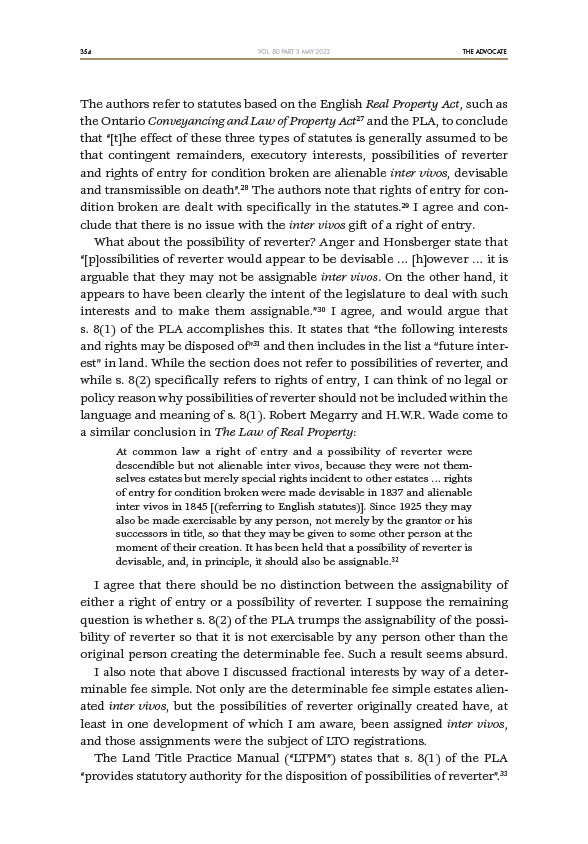
354 THE ADVOCATE
VOL. 80 PART 3 MAY 2022
The authors refer to statutes based on the English Real Property Act, such as
the Ontario Conveyancing and Law of Property Act27 and the PLA, to conclude
that “the effect of these three types of statutes is generally assumed to be
that contingent remainders, executory interests, possibilities of reverter
and rights of entry for condition broken are alienable inter vivos, devisable
and transmissible on death”.28 The authors note that rights of entry for condition
broken are dealt with specifically in the statutes.29 I agree and conclude
that there is no issue with the inter vivos gift of a right of entry.
What about the possibility of reverter? Anger and Honsberger state that
“possibilities of reverter would appear to be devisable … however … it is
arguable that they may not be assignable inter vivos. On the other hand, it
appears to have been clearly the intent of the legislature to deal with such
interests and to make them assignable.”30 I agree, and would argue that
s. 8(1) of the PLA accomplishes this. It states that “the following interests
and rights may be disposed of”31 and then includes in the list a “future interest”
in land. While the section does not refer to possibilities of reverter, and
while s. 8(2) specifically refers to rights of entry, I can think of no legal or
policy reason why possibilities of reverter should not be included within the
language and meaning of s. 8(1). Robert Megarry and H.W.R. Wade come to
a similar conclusion in The Law of Real Property:
At common law a right of entry and a possibility of reverter were
descendible but not alienable inter vivos, because they were not themselves
estates but merely special rights incident to other estates … rights
of entry for condition broken were made devisable in 1837 and alienable
inter vivos in 1845 (referring to English statutes). Since 1925 they may
also be made exercisable by any person, not merely by the grantor or his
successors in title, so that they may be given to some other person at the
moment of their creation. It has been held that a possibility of reverter is
devisable, and, in principle, it should also be assignable.32
I agree that there should be no distinction between the assignability of
either a right of entry or a possibility of reverter. I suppose the remaining
question is whether s. 8(2) of the PLA trumps the assignability of the possibility
of reverter so that it is not exercisable by any person other than the
original person creating the determinable fee. Such a result seems absurd.
I also note that above I discussed fractional interests by way of a determinable
fee simple. Not only are the determinable fee simple estates alienated
inter vivos, but the possibilities of reverter originally created have, at
least in one development of which I am aware, been assigned inter vivos,
and those assignments were the subject of LTO registrations.
The Land Title Practice Manual (“LTPM”) states that s. 8(1) of the PLA
“provides statutory authority for the disposition of possibilities of reverter”.33